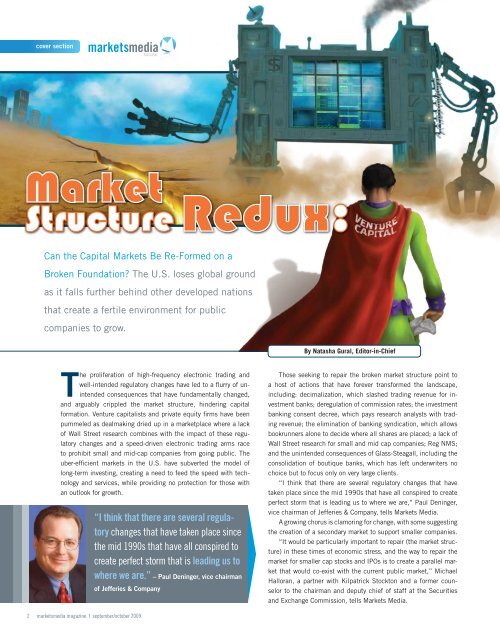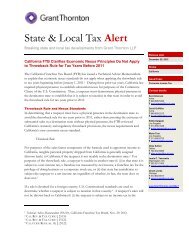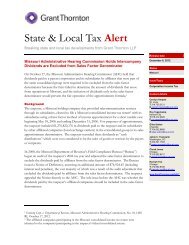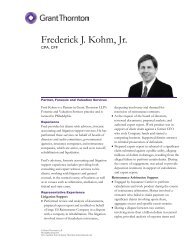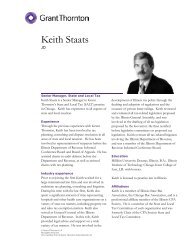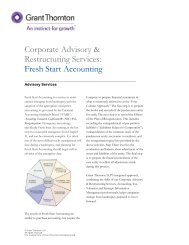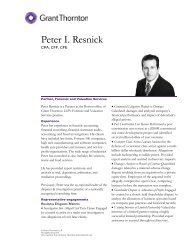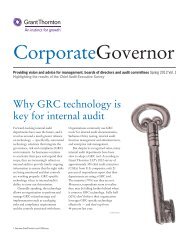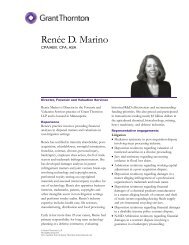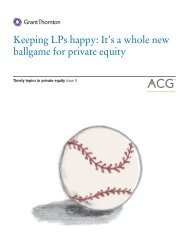Market Structure Redux - Grant Thornton LLP
Market Structure Redux - Grant Thornton LLP
Market Structure Redux - Grant Thornton LLP
You also want an ePaper? Increase the reach of your titles
YUMPU automatically turns print PDFs into web optimized ePapers that Google loves.
cover section<br />
<strong>Market</strong><br />
<strong>Structure</strong> <strong>Redux</strong>:<br />
Can the Capital <strong>Market</strong>s Be Re-Formed on a<br />
Broken Foundation? The U.S. loses global ground<br />
as it falls further behind other developed nations<br />
that create a fertile environment for public<br />
companies to grow.<br />
By Natasha Gural, Editor-in-Chief<br />
The proliferation of high-frequency electronic trading and<br />
well-intended regulatory changes have led to a flurry of unintended<br />
consequences that have fundamentally changed,<br />
and arguably crippled the market structure, hindering capital<br />
formation. Venture capitalists and private equity firms have been<br />
pummeled as dealmaking dried up in a marketplace where a lack<br />
of Wall Street research combines with the impact of these regulatory<br />
changes and a speed-driven electronic trading arms race<br />
to prohibit small and mid-cap companies from going public. The<br />
uber-efficient markets in the U.S. have subverted the model of<br />
long-term investing, creating a need to feed the speed with technology<br />
and services, while providing no protection for those with<br />
an outlook for growth.<br />
“I think that there are several regulatory<br />
changes that have taken place since<br />
the mid 1990s that have all conspired to<br />
create perfect storm that is leading us to<br />
where we are.” – Paul Deninger, vice chairman<br />
of Jefferies & Company<br />
Those seeking to repair the broken market structure point to<br />
a host of actions that have forever transformed the landscape,<br />
including: decimalization, which slashed trading revenue for investment<br />
banks; deregulation of commission rates; the investment<br />
banking consent decree, which pays research analysts with trading<br />
revenue; the elimination of banking syndication, which allows<br />
bookrunners alone to decide where all shares are placed; a lack of<br />
Wall Street research for small and mid cap companies; Reg NMS;<br />
and the unintended consequences of Glass-Steagall, including the<br />
consolidation of boutique banks, which has left underwriters no<br />
choice but to focus only on very large clients.<br />
“I think that there are several regulatory changes that have<br />
taken place since the mid 1990s that have all conspired to create<br />
perfect storm that is leading us to where we are,” Paul Deninger,<br />
vice chairman of Jefferies & Company, tells <strong>Market</strong>s Media.<br />
A growing chorus is clamoring for change, with some suggesting<br />
the creation of a secondary market to support smaller companies.<br />
“It would be particularly important to repair (the market structure)<br />
in these times of economic stress, and the way to repair the<br />
market for smaller cap stocks and IPOs is to create a parallel market<br />
that would co-exist with the current public market,” Michael<br />
Halloran, a partner with Kilpatrick Stockton and a former counselor<br />
to the chairman and deputy chief of staff at the Securities<br />
and Exchange Commission, tells <strong>Market</strong>s Media.<br />
2<br />
marketsmedia magazine I september/october 2009


